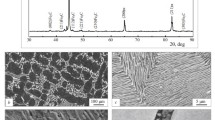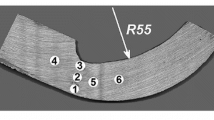Conclusions
-
1.
The use of HTTMT and vacuum melting increases the resistance of steel to brittle fracture and lowers the cold brittleness threshold, while increasing the work of crack propagation.
-
2.
After HTTMT the highest strength of vacuum heats is about 240 kg/mm2 at which the steel retains more or less satisfactory values of ductility and plasticity. After SHT of open heats this same strength is approximately 180 kg/mm2.
-
3.
We found no advantage of LTTMT over such a simple method of increasing the strength as increasing the carbon concentration (by about 0.1%).
Similar content being viewed by others
Literature cited
M. L. Bernshtein, Thermomechanical Treatment of Steel and Alloys [in Russian], Metallurgiya, Moscow (1968).
A. P. Gulyaev and A. M. Kim-Khenkina, Metal. i Term. Obrabotka Metal., No. 4 (1969).
A. P. Gulyaev, V. D. Zelenova, and I. V. Shermazan, Zavod. Lab., No. 7 (1966).
C. Crussard, R. Borione, et al., Rev. de Metallurgie, No. 6 (1956).
A. P. Gulyaev, Zavod. Lab., No. 4 (1967).
Additional information
Central Scientific-Research Institute of Ferrous Metallurgy. Translated from Metallovedenie i Termicheskaya Obrabotka Metallov, No. 12, pp. 28–33, December, 1969.
Rights and permissions
About this article
Cite this article
Gulyaev, A.P., Kim-Khenkina, A.M. Effect of the carbon content, melting procedure, and thermomechanical treatment on the fracture toughness of steel. Met Sci Heat Treat 11, 952–957 (1969). https://doi.org/10.1007/BF00654931
Issue Date:
DOI: https://doi.org/10.1007/BF00654931




